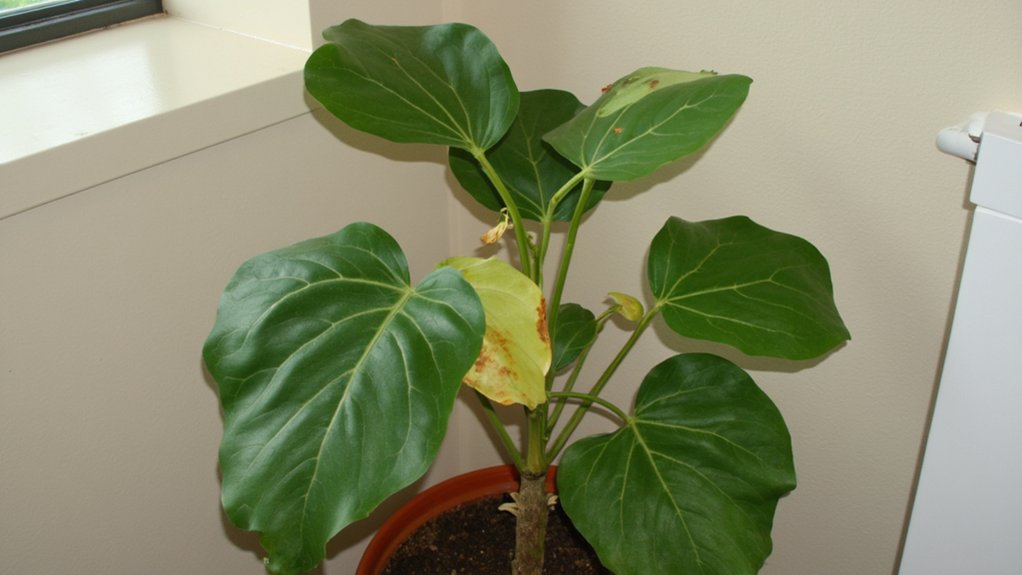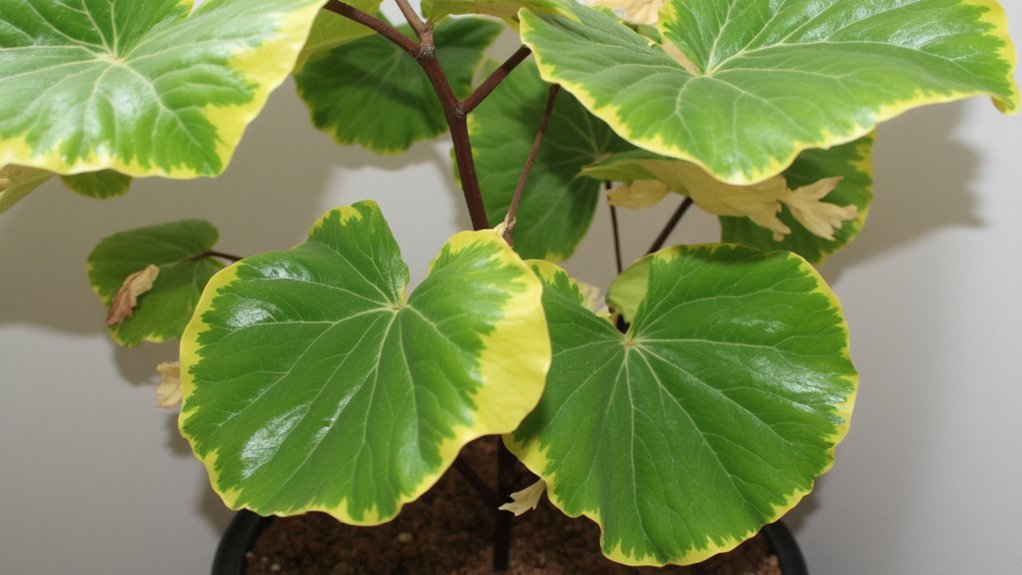Your Fiddle Leaf Fig’s drooping leaves and brown spots aren’t just random symptoms – they’re your plant’s way of communicating specific problems. Whether it’s struggling with inconsistent watering, battling low light conditions, or fighting off a pest invasion, these telltale signs point to fixable issues. By learning to decode these distress signals and implementing targeted solutions, you’ll transform your struggling plant into a thriving specimen that showcases those characteristic glossy leaves.
Contents
Common Signs of Distress in Fiddle Leaf Figs

Although fiddle leaf figs are known for their stunning foliage, they’ll quickly show signs when something isn’t right. The most obvious indicators include yellowing leaves, brown spots, leaf drop, and wilting or drooping branches.
You’ll notice the first signs of trouble in the leaves, which may develop dark brown spots along the edges or in the center. The plant’s overall structure might become leggy, with gaps between leaves and unstable stems that can’t support the weight of the foliage.
Watch for leaves that curl inward, develop a dull appearance, or show signs of insect damage, like tiny holes or sticky residue.
Watering Issues: Too Much or Too Little?

The two most common problems with fiddle leaf figs stem from incorrect watering habits – either drowning your plant or leaving it parched. You’ll know you’re overwatering when leaves turn brown and mushy, especially at their edges. The soil will feel consistently wet, and you might notice a musty odor.
Underwatering shows up as crispy, dry brown spots and drooping leaves. If you stick your finger 2 inches into the soil and it’s completely dry, your plant needs water. The ideal watering schedule is typically once every 7-10 days, but you’ll need to adjust based on your home’s humidity and temperature.
Lighting Requirements and Location Matters

Because fiddle leaf figs naturally grow under bright, filtered sunlight in tropical forests, your plant needs plenty of indirect light to thrive indoors. Place your fig 3-6 feet from a north or east-facing window, where it’ll receive 6-8 hours of bright, indirect light daily.
Watch for signs of improper lighting. If leaves turn yellow or brown, you’re likely giving too much direct sun. If you notice leggy growth or dropping leaves, your fig isn’t getting enough light. Consider using a sheer curtain to filter harsh rays, or supplement dim areas with a grow light positioned 12-18 inches above the plant.
Don’t place your fig near drafty windows, air vents, or frequently opened doors.
Temperature and Humidity Concerns
Since fiddle leaf figs originate from warm, humid rainforests, maintaining proper temperature and humidity levels is essential for their survival. Keep your plant in temperatures between 60-75°F (15-24°C), and don’t let it drop below 55°F at night.
You’ll need to maintain humidity levels of 40-60%. If your home’s air is dry, use a humidifier or create a pebble tray filled with water beneath the pot. Keep your fig away from heating vents and cold drafts, which can cause leaf drop and brown spots.
Monitor the plant during seasonal changes, when indoor temperatures and humidity fluctuate most dramatically.
Pest Identification and Treatment
While maintaining proper temperature and humidity helps prevent many problems, your fiddle leaf fig can still fall prey to unwanted visitors. Spider mites, mealybugs, and scale insects are the most common pests you’ll encounter.
Check your plant’s leaves weekly, especially the undersides. If you spot tiny webs, white fuzzy spots, or brown bumps, you’ve got trouble. Treat spider mites with neem oil spray, applying every 7 days for 3 weeks. For mealybugs and scale, dab them directly with rubbing alcohol using a cotton swab.
Don’t forget to isolate infected plants immediately and inspect neighboring plants for cross-contamination.
Root Health and Repotting Guidelines
Although healthy roots are essential for your fiddle leaf fig’s survival, many plant owners don’t check them until problems arise. You’ll need to inspect your plant’s roots every 6-12 months, looking for signs of rot or overcrowding.
To check root health, gently remove the plant from its pot. Healthy roots should be firm and white or tan, while black, mushy roots indicate rot. If you spot rot, trim affected areas with sterilized shears and repot in fresh soil.
Repot your fiddle leaf fig when roots circle the bottom or grow through drainage holes. Choose a pot 2-3 inches larger, using well-draining soil and maintaining proper moisture levels.
Recovery Tips and Maintenance Strategies
Once your fiddle leaf fig shows signs of distress, you’ll need to act quickly with targeted recovery measures. First, adjust your watering schedule to every 7-10 days, ensuring the top 2 inches of soil dry between waterings. Position your plant 3-6 feet from a bright window, avoiding direct afternoon sun.
Maintain humidity at 60% by misting twice weekly or using a pebble tray. Remove damaged leaves with clean, sharp scissors, making cuts at 45-degree angles. Feed your plant monthly with a balanced 3-1-2 NPK fertilizer during growing season, diluted to half strength.
Rotate your plant quarterly to promote even growth, and dust leaves biweekly with a damp microfiber cloth.
